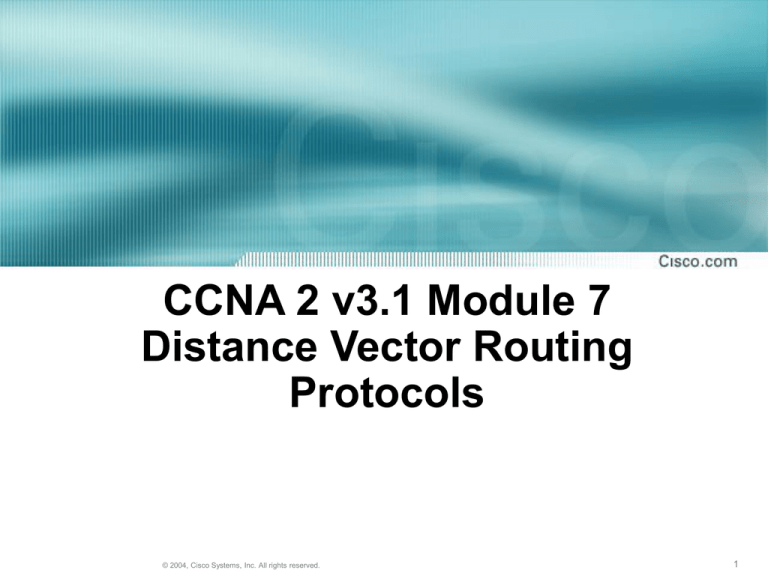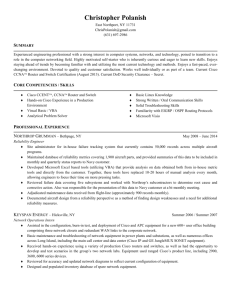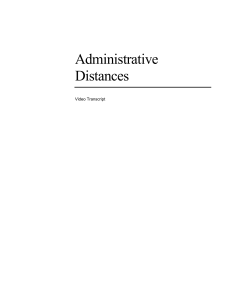
CCNA 2 v3.1 Module 7
Distance Vector Routing
Protocols
© 2004, Cisco Systems, Inc. All rights reserved.
1
Purpose of This PowerPoint
• This PowerPoint primarily consists of the Target
Indicators (TIs) of this module in CCNA version
3.1.
• It was created to give instructors a PowerPoint to
take and modify as their own.
• This PowerPoint is:
NOT a study guide for the module final assessment.
NOT a study guide for the CCNA certification exam.
• Please report any mistakes you find in this
PowerPoint by using the Academy Connection
Help link.
© 2004, Cisco Systems, Inc. All rights reserved.
2
To Locate Instructional Resource
Materials on Academy Connection:
• Go to the Community FTP Center to locate
materials created by the instructor community
• Go to the Tools section
• Go to the Alpha Preview section
• Go to the Community link under Resources
• See the resources available on the Class home
page for classes you are offering
• Search http://www.cisco.com
• Contact your parent academy!
© 2004, Cisco Systems, Inc. All rights reserved.
3
Objectives
© 2004, Cisco Systems, Inc. All rights reserved.
4
Distance Vector Updates
© 2004, Cisco Systems, Inc. All rights reserved.
5
Problem: Routing Loops
• Routing loops can occur when
inconsistent routing tables are not
updated due to slow convergence in a
changing network.
© 2004, Cisco Systems, Inc. All rights reserved.
6
Problem: Counting to Infinity
© 2004, Cisco Systems, Inc. All rights reserved.
7
Solution: Defining a Maximum for
Infinity
© 2004, Cisco Systems, Inc. All rights reserved.
8
Solution: Split Horizon
© 2004, Cisco Systems, Inc. All rights reserved.
9
Solution: Route Poisoning
© 2004, Cisco Systems, Inc. All rights reserved.
10
Solution: Triggered Updates
© 2004, Cisco Systems, Inc. All rights reserved.
11
Solution: Holddown Timers
© 2004, Cisco Systems, Inc. All rights reserved.
12
Key Characteristics of RIP
© 2004, Cisco Systems, Inc. All rights reserved.
13
RIP Commands
• Using router rip and network
commands to Enable RIP
• Enabling RIP on an IP-addressed network
• Monitoring IP packet flow using the show
ip protocol command
• The show ip route command
© 2004, Cisco Systems, Inc. All rights reserved.
14
Configuring RIP
© 2004, Cisco Systems, Inc. All rights reserved.
15
Using the ip classless Command
© 2004, Cisco Systems, Inc. All rights reserved.
16
The show ip protocols Command
© 2004, Cisco Systems, Inc. All rights reserved.
17
The show ip route Command
© 2004, Cisco Systems, Inc. All rights reserved.
18
Troubleshooting RIP Update Issues
• debug ip rip
• show ip protocols {summary}
• show ip route
• debug ip rip {events}
• show ip interface brief
© 2004, Cisco Systems, Inc. All rights reserved.
19
Preventing Routing Updates through
an Interface
© 2004, Cisco Systems, Inc. All rights reserved.
20
Load Balancing with RIP
© 2004, Cisco Systems, Inc. All rights reserved.
21
Administrative Distance
© 2004, Cisco Systems, Inc. All rights reserved.
22
Integrating Static Route with RIP
• A router running RIP can receive a default
route via an update from another router
running RIP.
• Another option is for the router to
generate the default route itself.
• The administrator can override a static
route with dynamic routing information by
adjusting the administrative distance
values.
© 2004, Cisco Systems, Inc. All rights reserved.
23
Integrating Static Route with RIP
• Static routes that point out an interface will be
advertised by the RIP router that owns the static
route and propagated throughout the
internetwork. This is because static routes that
point to an interface are considered in the
routing table to be connected and thus lose their
static nature in the update. If a static route is
assigned to an interface that is not defined in a
network command, a redistribute static
command must be specified in the RIP process
before RIP will advertise the route.
© 2004, Cisco Systems, Inc. All rights reserved.
24
IGRP Features
© 2004, Cisco Systems, Inc. All rights reserved.
25
IGRP Commands
• Using router igrp and network
commands to enable IGRP
• Enabling IGRP on an IP-addressed
network
• Monitoring IP packet flow using the show
ip protocol command
• The show ip interfaces command
• The show ip route command
• The debug ip rip command
© 2004, Cisco Systems, Inc. All rights reserved.
26
IGRP Metrics
• Bandwidth – The lowest bandwidth value
in the path
• Delay – The cumulative interface delay
along the path
• Reliability – The reliability on the link
towards the destination as determined by
the exchange of keepalives
• Load – The load on a link towards the
destination based on bits per second
© 2004, Cisco Systems, Inc. All rights reserved.
27
IGRP Routes:
Interior, System, & Exterior
© 2004, Cisco Systems, Inc. All rights reserved.
28
IGRP Stability Features
• Holddowns, Split horizons, & Poison-reverse
updates
© 2004, Cisco Systems, Inc. All rights reserved.
29
Configuring IGRP
© 2004, Cisco Systems, Inc. All rights reserved.
30
Migrating RIP to IGRP
1. Verify existing routing protocol (RIP) on
the routers to be converted.
2. Configure IGRP on RouterA and RouterB
3. Enter show ip protocols on RouterA
and RouterB
4. Enter show ip route on RouterA and
RouterB
© 2004, Cisco Systems, Inc. All rights reserved.
31
Migrating RIP to IGRP
© 2004, Cisco Systems, Inc. All rights reserved.
32
Verifying IGRP Configuration
• Some commands for checking IGRP
configuration are as follows:
show interface interface
show running-config
show running-config interface
interface
show running-config | begin interface
interface
show running-config | begin igrp
show ip protocols
© 2004, Cisco Systems, Inc. All rights reserved.
33
Troubleshooting IGRP
• The following commands are useful when
troubleshooting IGRP:
show ip protocols {summary}
show ip route
debug ip igrp events IGRP protocol
events
debug ip igrp transactions IGRP
protocol transactions
ping
traceroute
© 2004, Cisco Systems, Inc. All rights reserved.
34
Summary
© 2004, Cisco Systems, Inc. All rights reserved.
35





